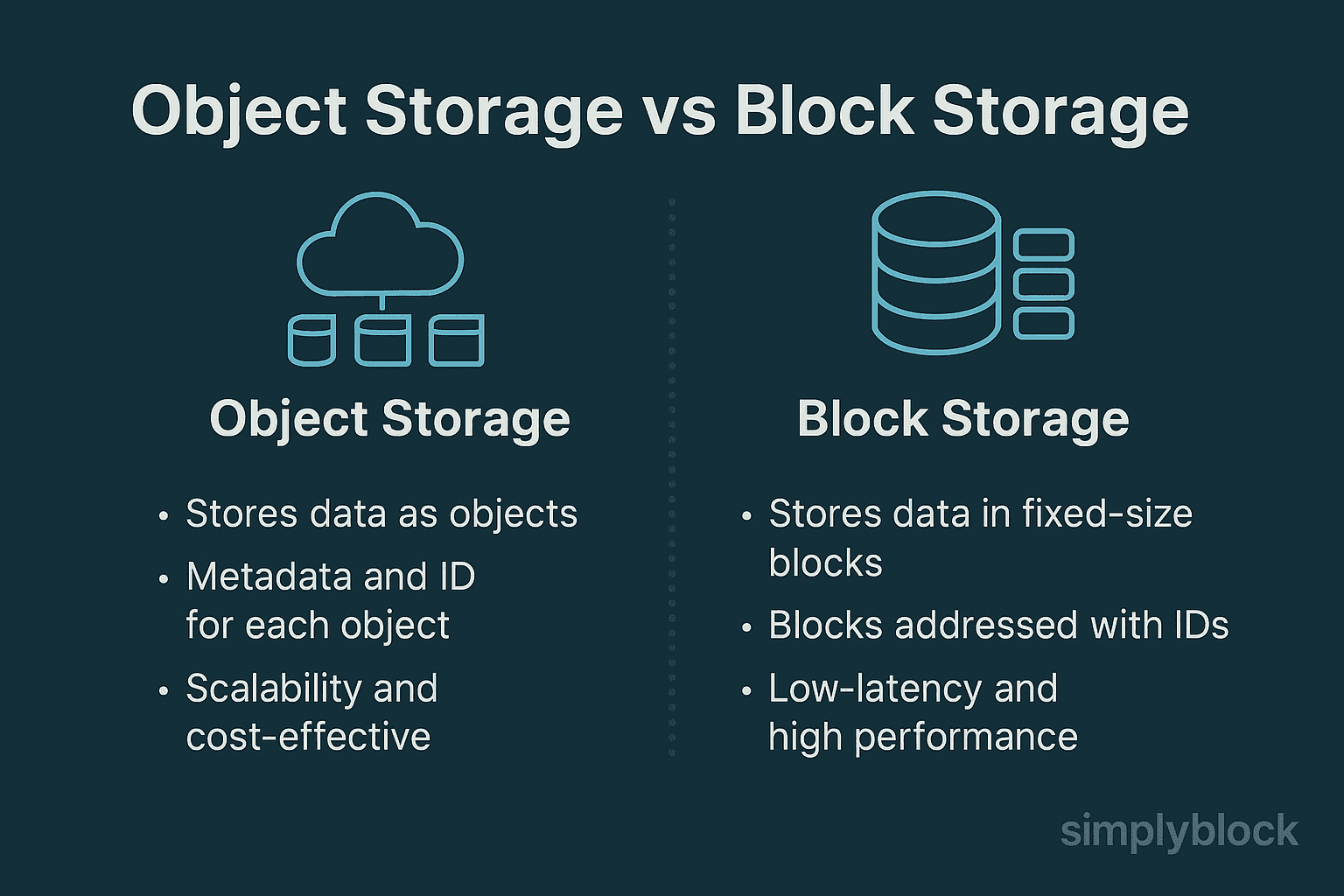Object Storage vs Block Storage
Terms related to simplyblock
Object storage and block storage are two fundamentally different data storage architectures optimized for distinct use cases.
- Block storage divides data into fixed-size chunks (blocks) that are individually addressable and structured for low-latency I/O. It’s the backbone of high-performance applications like databases, VMs, and Kubernetes persistent volumes.
- Object storage treats data as discrete units called objects, each bundled with metadata and a unique identifier. It’s designed for scalability, archival, and unstructured data like backups, logs, media, or analytics workloads.
Choosing between object and block storage depends on performance needs, data structure, and access patterns—and platforms like simplyblock™ are purpose-built to deliver high-performance block storage for real-time, transactional use cases.
What Is Object Storage Used For?
In object storage, each file is stored as a single object with its data, metadata, and ID. There’s no hierarchy or filesystem. Instead, it uses HTTP-based APIs (e.g., S3) to store and retrieve data. This architecture is ideal for:
- Unstructured data (images, videos, backups)
- Massive scalability across distributed systems
- Lower storage cost with durability and replication
However, object storage generally trades off latency and IOPS in exchange for scalability and simplicity.

What Is Block Storage Used For?
Block storage splits data into evenly sized blocks and allows fast, byte-level access to them. These blocks are attached to compute nodes as volumes or devices, allowing you to format them with the desired filesystem and use them just like a physical disk.
Block storage is highly suited for:
- Databases with transactional workloads
- Virtual machine disks and hypervisors
- Kubernetes persistent volumes via CSI
With platforms like simplyblock, block storage is delivered over NVMe/TCP, combining high throughput, low latency, and flexibility for cloud-native environments.
Object Storage vs Block Storage: Feature Comparison
Choosing between object storage and block storage affects your system’s speed, cost, and future expansion. This comparison explains their strengths and limits so you can match the right option to your workload.
| Feature | Block Storage | Object Storage |
|---|---|---|
| Data Access | Byte-level, via device | Object-level, via API (e.g., S3) |
| Performance | Low latency, high IOPS | High throughput, higher latency |
| Use Case Suitability | Databases, VMs, Kubernetes volumes | Backups, media, logs, data lakes |
| Protocols | iSCSI, NVMe/TCP, FC | S3, Swift, HTTP |
| File System Integration | Yes (ext4, XFS, NTFS, etc.) | No filesystem, flat namespace |
| Kubernetes Integration | CSI native | External or S3 gateway only |
| Scalability | Vertical and horizontal | Horizontal, virtually unlimited |
| Cost per GB | Higher | Lower |
When to Use Block vs Object Storage
Match storage to usage patterns for best speed and savings. Learn when block storage delivers low-latency performance and when object storage wins with limitless capacity and lower cost.
Use Block Storage When:
- You need low-latency access to data
- Applications require a filesystem
- You’re running SQL/NoSQL databases, VM workloads, or CI/CD pipelines
- Persistent volumes are required in Kubernetes
Use Object Storage When:
- You’re archiving large datasets
- Your workloads involve static files or logs
- Metadata management is critical (e.g., data lakes)
- Scalability is prioritized over latency
How Simplyblock Delivers Block Storage
Simplyblock is designed for high-performance, NVMe-grade block storage. It is optimized for:
- Kubernetes environments using CSI drivers
- High throughput, sub-millisecond latency via NVMe-over-TCP
- Advanced data protection with erasure coding
- Built-in multi-tenancy, QoS, and snapshot support
Simplyblock focuses on the block storage layer, complementing cloud-native object stores such as S3 rather than duplicating them.
External Resources
- Block Storage – TechTarget
- Object Storage – Red Hat
- S3 Storage Basics – AWS
- Block vs Object Storage – IBM
- Kubernetes Storage Overview
Questions and Answers
Block storage stores data in fixed-size chunks with low-latency access, ideal for databases and virtual machines. Object storage manages data as discrete objects with metadata, perfect for backups, media, and unstructured data. Each is optimized for different performance and access patterns.
For Kubernetes workloads that need persistent, high-performance volumes—such as databases—block storage is preferred. Object storage is better suited for storing logs, backups, and static assets accessed through APIs rather than mounted filesystems.
Generally yes. Object storage is more cost-efficient for large volumes of infrequently accessed data. Block storage, especially NVMe over TCP, is more expensive but necessary for performance-sensitive apps like OLTP databases or analytics engines.
Yes, many architectures use both. Active workloads run on high-speed block storage, while archival or static content is offloaded to object storage. This hybrid approach can be automated with storage tiering strategies.
Both support encryption, but block storage encryption often includes volume-level key isolation and per-tenant security controls. Object storage typically offers bucket-level policies, which may not be as granular in multi-tenant scenarios.
